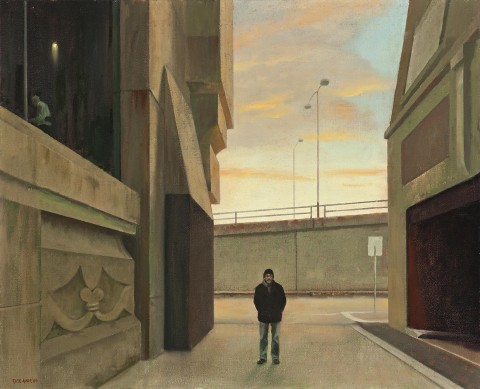STUDY FOR A PORTRAIT, 2004
RICK AMOR
oil on canvas
81.0 x 100.0 cm
signed and dated lower left: RICK AMOR ‘04
dated and inscribed with title verso: July '04 / Study for a / Portrait / …
Private collection, Melbourne, acquired directly from the artist in 2004
Grishin, S., Accounting for Taste: The Lowensteins Arts Management Collection, Macmillan Art Publishing, Melbourne, 2013, p. 52 (illus.)
‘I’ve always thought that what we see is not necessarily what’s there. There’s extra things we don’t see, there’s layers of reality... The twentieth century seems to be a struggle to relate perception to reality…’1
A consummate painter, sculptor and printmaker with a highly successful career spanning four decades, Rick Amor is the master of transforming the ordinary into the extraordinary. Although drawing inspiration from the seemingly mundane, everyday sites of suburbia and the drab underside of the city, his paintings are typically full of drama, deep melancholy and foreboding – resonating with a disquieting sense of both beauty and menace that alludes to the ambiguities inherent in life and humanity’s complex existence. Far from being literal translations, Amor’s urban landscapes have evolved, rather, over a number of years, and consequently reveal several layers of memory, knowledge and perception – together with the influence of literature concerning cities from T.S. Eliot’s poetic verse to the classic dystopian texts of George Orwell and Franz Kafka. As Paul McGillick observes of Amor’s work, ‘…this is a phenomenological process by which the world as we think we see it is actually a construction based only partly on our understanding of it… there is a disconcerting quality to his pictures, as though they were not so much snapshots of reality as frozen frames from the moving pictures of our dreams’.2
As exemplified superbly by Study for a Portrait, 2004, a motif frequently punctuating Amor’s urban landscapes is that of the solitary individual, alone and dissociated in his environment. Dwarfed by the grandiose carved stone foundations of the building to the left and modern monolithic structure to the right, here a hooded protagonist stares out resolutely from the murky, shadowed alley – the scene imbued with characteristic stillness and suspense. Heightening his isolation is the inclusion of another lone figure (reminiscent of Amor’s celebrated Waiter with his crisp white shirt) who toils away behind the glass window, seemingly oblivious to the presence of either the artist or his anonymous laneway character. Although a fabricated world in the same manner as the meticulously arranged, haunted piazzas and streetscapes of Italian Surrealist painter, Giorgio de Chirico, one cannot help but feel an uncanny sense of familiarity, of something already experienced, or deja vu. Indeed, such is the evocative power and enduring appeal of Amor’s vision which, despite being the outward expression of his own inner life, nevertheless engages the collective unconscious of universal experiences, thoughts and feelings to poignantly reflect upon the complexities of the human condition more broadly. As the artist himself muses,
‘…the pictures are real to me and I would love to find these places and walk into them. I hope that my world is sometimes as convincing to the viewer as it is to me’.3
1. Amor, R., in Catalano, G., Building a Picture: Interviews with Australian Artists, McGraw Hill, Melbourne, 1997, p. 141
2. McGillick, P., ‘The City as Dream - The New York Paintings of Rick Amor’, Monument, no. 22, 1998, pp. 84 – 88
3. Amor, R., On Brack, Bren and Picasso, exhibition catalogue, TarraWarra Museum of Art, Victoria, 2006, n.p.
VERONICA ANGELATOS
